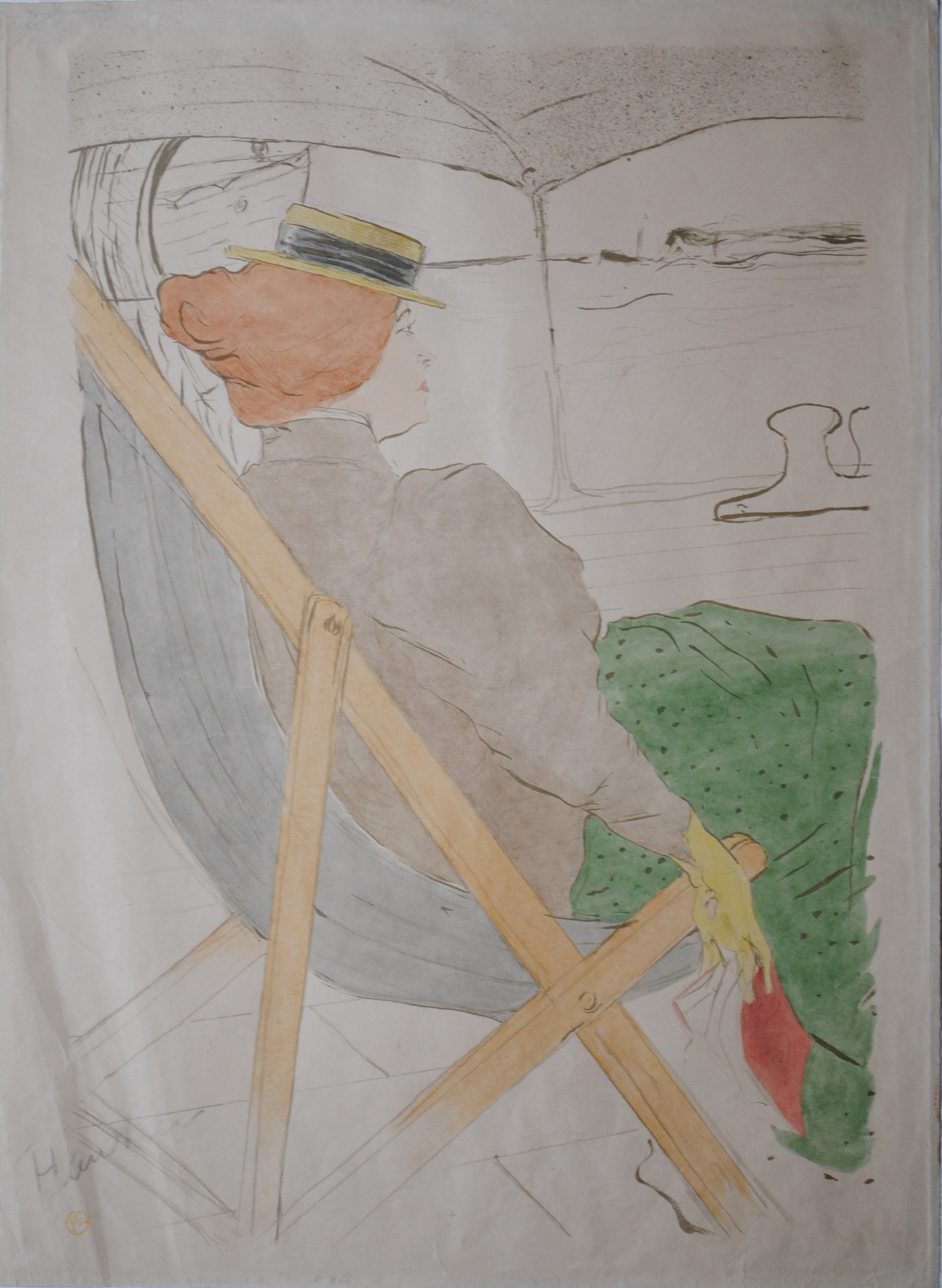
|
|
La
Passagère du 54 — Promenade en Yacht
Delteil 366 (1st state not described), Wittrock P20 I/III;
Adriani 137 I/III
lithograph, 1895*, on cream Japon Impérial paper,
the 1st state (of 3), a rare and
exceptional working proof impression, printed in grayish olive-green, signed
in black crayon by the artist (the signature somewhat rubbed),
and bearing the artist's red stamp Lugt 1338, faded), an unnumbered impression,
with
full margins, one of only a
few proofs of this state, aside from the first edition of 50,
extensively touched in graphite pencil, and heightened with watercolor,
very slight soiling and lightstaining overall,
marginal hinges on the reverse margin, as well as some scuffing along
the extreme sheet edge, a few soft handling creases, notably in the
lower left corner, occasional horizontal hairline compression creases (cassures) to the
paper within the image, otherwise in rather good overall condition
L. 600x400 mm., S. 640x467 mm.

|
This is one of Toulouse-Lautrec's most subtle lithographs, and the story behind the passenger in Cabin 54, as related by Gustave Coquiot (Henri de Toulouse-Lautrec, Paris 1913:179-180), is worth recalling here:
In the summer of 1895 Lautrec embarked on a voyage from Le Havre to Bordeaux with Maurice Guibert, on the steamer Le Chili.
During the voyage he discovered a young woman, one of his fellow
passengers, in cabin No. 54, who was on her way to join her husband, a
colonial official in Senegal. He was so fascinated by her beauty that,
despite protests from Guibert, he determined to stay on board once the
ship reached Bordeaux and continue south with the vessel. It was
not until they reached Lisbon that his friend succeeded in getting
Lautrec — who was determined to carry on as far as Dakar — off the
ship. Guibert then took the artist via Madrid and Toledo to the spa of
Taussat, and the trip ended in late summer near Bordeaux, at the
Château de Malromé, the main residence of Lautrec’s mother.
Back in Paris,
Toulouse-Lautrec developed this major lithograph attentively, if
rapidly, working from a photograph taken on board, two known sketches
(Dortu D.4183 and D.4199), and a carefully worked full-scale
preliminary study (Dortu D.4254).
He intended a large color print from the outset, as is clearly shown by
the registration marks already present in the keystone printing (i.e. for the 1st edition, in olive green).
Furthermore, there are no variant states, apart from the addition of
the five color stones and the lettering, so the image drawing was clearly in
place quite early on, with no real modifications.
Executed in an alert and rapid hand, the graphite retouching is focused
on the figure, in fine pencil: the upper contour of the straw boater (canotier),
the backswept hair, the contours of the shirt and jacket lapel, the
seam and fold in the puffed shoulder of the sleeve, the almost fussy
upturn of the glove cuff, the long curves of the deck chair, and the
even shading on the cover of the open book. This rework would
seem to correspond to the red highlights to be added in the color
version.
The hand coloring is different from that of the final print (below)
in several aspects: the light, uniform gray fabric in the deck chair,
the flowing green skirt, and the yellow and red are inverted in the
glove and book. The yellowish color of the boater, the strikingly red
hair, and the pale taupe jacket are nearly identical. This
refined coloring is possibly the work of the chromiste,
in order to determine the visual impact of such broad and uniform color
fields for the final version, again focusing on the central figure.
The present impression is quite different from that in the Art
Institute of Chicago (the only known working impression, see below),
which only shows much more succinct color references, in quick dabbing
strokes, probably by the artist himself.
This lithograph in any case met with laudatory approval:
"Chose exquise de ton, d'élégance, d'expression de laisser-aller, de la
douceur de vivre, le regard errant, par beau temps."
- Maurice
Joyant, Henri de Toulouse-Lautrec : Dessins, estampes, affiches, Tome 2, Paris 1926:189.
* Wittrock gives 1896, though according to Adriani, the opening of the Salon's Exposition internationale d'affiches took place in October 1895.
See the full color impression of the second state now in the Bibliothèque Nationale:
http://www.photo.rmn.fr/C.aspx?VP3=SearchResult&VBID=2CO5PC27YT91&SMLS=1&RW=1200&RH=966
Cf. the impression from the edition of the first state in the 1-2 May 2014 sale at Sotheby's:
http://www.sothebys.com/en/auctions/ecatalogue/2014/prints-n09138/lot.139.html
as well as the impression,
printed in a dark grayish-black on ivory wove, and also
touched with watercolor, which is the only known impression aside from
the first edition, now in the Art Institute of Chicago:
http://www.artic.edu/aic/collections/artwork/67035?search_no=52&index=487


